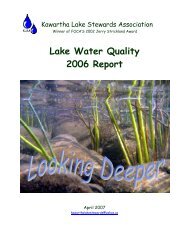Phosphorus and the Kawartha Lakes - Lakefield Herald
Phosphorus and the Kawartha Lakes - Lakefield Herald
Phosphorus and the Kawartha Lakes - Lakefield Herald
Create successful ePaper yourself
Turn your PDF publications into a flip-book with our unique Google optimized e-Paper software.
5.0 Past <strong>and</strong> Present <strong>Phosphorus</strong> levels in <strong>the</strong> <strong>Kawartha</strong> <strong>Lakes</strong><br />
Introduction<br />
This is <strong>the</strong> final chapter to present new datum <strong>and</strong> concentrates on elucidating<br />
patterns in phosphorus concentrations across both time, <strong>and</strong> <strong>the</strong> lake continuum (Balsam<br />
to Katchewanooka Lake).<br />
Methodology<br />
Appropriate historical datum was found from two sources (Hutchinson et al.,<br />
1994; MOE, 1976). Datum from 1972, 1976 (MOE, 1976) 2003, 2004, <strong>and</strong> 2005<br />
(KLSA, 2006) were compared using two techniques; analysis of variance (ANOVA) with<br />
Tukey’s tests for significance, <strong>and</strong> interpretation of spline curve scatter plot. Similarly,<br />
consistently sampled phosphorus concentrations for Sturgeon Lake 1971-1991<br />
(Hutchinson et al., 1994) were analysed using linear regression. A second linear<br />
regression was performed using <strong>the</strong> 1971-1991 data along with KLSA’s data from 2003-<br />
2005. Finally, non-linear regression was employed to determine if any patterns exist in<br />
phosphorous concentration along <strong>the</strong> lake continuum (Balsam-Katchewanooka).<br />
ANOVA analyses could only be conducted to compare three different years of datum,<br />
1972, 1976 <strong>and</strong> 2005. O<strong>the</strong>r years could not be utilized, as <strong>the</strong> datum was incomplete for<br />
a legitimate analysis. Similarly, <strong>the</strong> following ten lakes were utilized in <strong>the</strong> ANOVA<br />
analysis as no suitable data was found for o<strong>the</strong>r lakes; Balsam, Big Bald, Upper<br />
Buckhorn, Cameron, Clear, Katchewanooka, Pigeon, Upper Stony, Lower Stony <strong>and</strong><br />
Sturgeon.<br />
Results<br />
ANOVA analysis demonstrated a significant response in phosphorus<br />
concentration across years. A Tukey’s post-hoc test revealed that 2005 total phosphorus<br />
concentrations had decreased significantly (p < 0.05) from 1972 levels (Figure 5.1).<br />
Linear regression demonstrated a marginally significant (p = 0.069, r 2 = 0.17)<br />
negative trend in phosphorus concentrations across years (1971-1991) <strong>and</strong> a significant (p<br />
= 0.02, r 2 = 0.22) negative trend across years when <strong>the</strong> KLSA (2003-2005) datum was<br />
included (Figure 5.2).<br />
The spline curve scatter plot is not a test of significance but demonstrates that<br />
Figures 5.1 <strong>and</strong> 5.2 should be interpreted cautiously. Figure 5.3 obscures <strong>the</strong> decreasing<br />
trend in phosphorus concentrations: had appropriate 2003 datum been available, ANOVA<br />
analysis may have revealed that phosphorus concentrations had reverted back to 1972<br />
levels.<br />
Finally, Figure 5.4 shows a significant non-linear (logistic 3-parameter) (p <<br />
0.001, r 2 = 0.80) positive relationship of lake accumulation with phosphorus<br />
18





